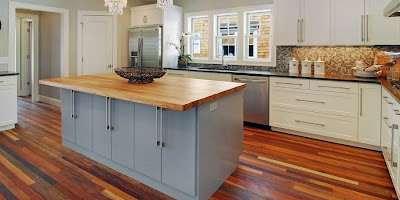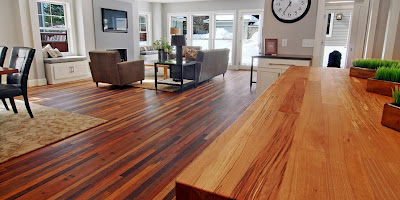 |
| Love the island and flooring in this kitchen |
This is a sponsored post by Viridian Wood, a company specializing in furniture salvaging and recycling. I like the cool products they have created and thought you would too.
Nothing in this world stays the same; everything is shifting from one form into another. However, we can sometimes change the direction of the shift. For instance, rather than allowing old stumps to rot in place, some reclaimed redwood paneling experts are turning them into like-new redwood panels.
This is only one route to salvaging wood. For instance, vintage gymnasium seats can be transformed into cheery café tables, or old barn beams may be used as support beams in a custom home. The following is a look at common salvage sources for reclaimed redwood products, as well as details about how one manufacturer reclaims old-growth stumps into stunning redwood panels.
Introduction to Reclaimed Wood
In the last decade or so, manufacturers have made several innovations in the process of salvaging used wood. Their work has decreased the demand for virgin wood, thereby reducing deforestation.
This is important because forests are the “lungs” of the planet. They “inhale” huge amounts of carbon dioxide and “exhale” fresh oxygen. As the percentage of forested land on Earth shrinks, it becomes harder and harder to offset the increased carbon dioxide emissions that human activity spews into the atmosphere. Many consumers choose reclaimed redwood, Douglas fir, and oak products because they are dedicated to the idea of making environmentally conscious purchasing choices.
Although reclaimed redwood panels and other salvaged wood products are “green,” they are also just as warm, smooth and elegant as their virgin wood counterparts. Indeed, many of today’s consumers prefer reclaimed redwood and reclaimed oak products. These buyers appreciate seeing “previous lives” in the nail oxidation streaks, saw marks and other telltale clues of a previous incarnation. Reclaimed wood products have a classic yet intriguing look that designers love, as well. Many retail spaces and restaurants are employing reclaimed redwood and other salvaged timbers, knowing their shoppers are interested in supporting eco-friendly causes.
Common Salvage Sources for Reclaimed Wood
As mentioned earlier, gymnasiums and barns are potential sources of salvaged wood. Like the tumbledown pioneer-era barns that dot the American landscape, old school houses often feature long, incredibly strong beams cut from old-growth timber. When it is salvaged, this timber is often stronger than virgin wood products. Old-growth timber is much tighter and stronger than timber taken from first-generation forests, as most of today’s new wood products are. Indeed, old-growth wood can be up to 40 points harder on the Janka scale, which measures a wood’s resistance to wear and denting.
Shipping containers are another excellent source of reclaimable timbers. Viridian Wood’s Jakarta Market Blend is reclaimed from transpacific shipping crates. It is available in paneling, flooring and even decking. Viridian resurfaces and reclaims the Asian hardwoods found in shipping containers. They strip away the external dings and dirt, revealing the gorgeous, very hard underlying timber.
How Redwood is Salvaged
Reclaimed redwood can come from several different sources. Viridian’s wine tank redwood, paneling, for instance, is reclaimed from California wine casks. Another source of reclaimed redwood comes from organizations that are finishing the work of turn-of-the-century loggers by salvaging old-growth stumps that old-time loggers lacked the technology to remove.
In those days, Northern California loggers were chopping down redwood giants that had stood for centuries. In the process, they left enormous stumps that were impossible to remove with contemporary technology.
Today, while harvesting third-growth timber, logging crews sometimes discover old “buckskin logs” and stumps that were left in place during logging efforts in the early 1900s. Some of these old-growth stumps measure thirty feet across; they contain large amounts of usable timber, which can be transformed into beautiful reclaimed redwood paneling and other products
Compared to today’s redwood paneling, reclaimed redwood panels are harder. They have a tighter grain because they were culled from old-growth timber. The color of reclaimed redwood paneling is often richer as well. When installed in a home or business, these redwood panels stand out for their beauty. Business owners love having the chance to tell customers about where the panels above their table or sales desk came from, and homeowners appreciate the fact that they made an earth-friendly choice when buying redwood paneling.
Joe Mitchoff is the co-founder of Viridian Reclaimed Wood, a wood flooring, paneling and furniture salvaging and recycling company based in Portland, Oregon. Learn more about how we pioneer new and efficient methods of post-industrial reclamation and conservation on our website or on Facebook.






Wow! this wood looks amazing for the flooring and i think this must be affordable too.Thanks for sharing information about it.